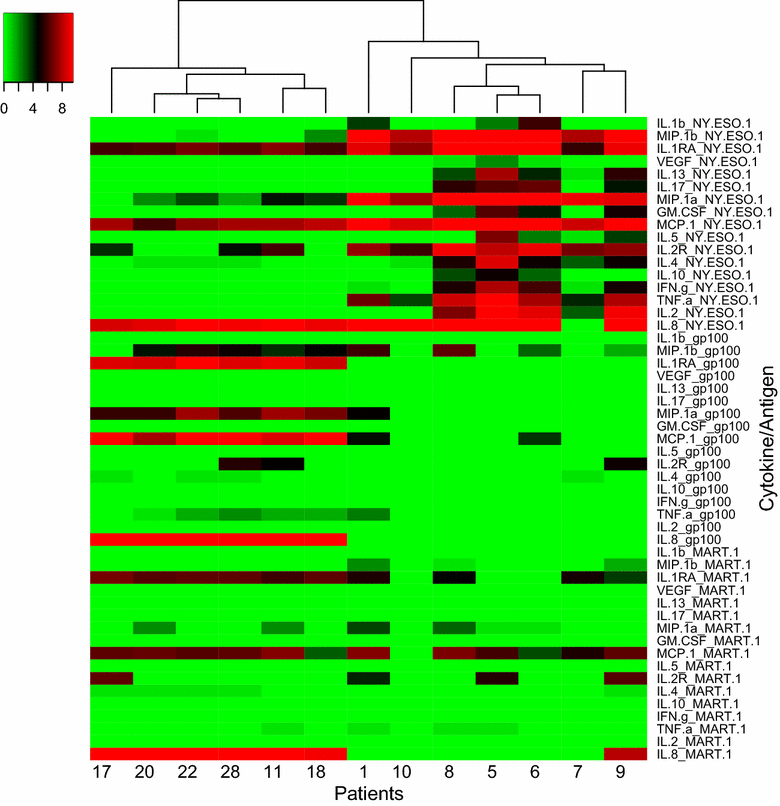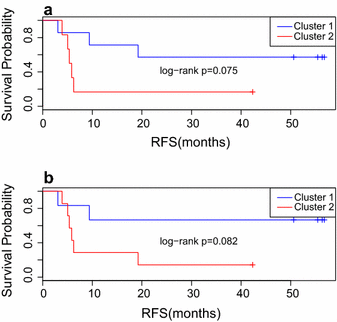Melanoma antigen-specific effector T cell cytokine secretion patterns in patients treated with ipilimumab
- PMID: 28222797
- PMCID: PMC5319167
- DOI: 10.1186/s12967-017-1140-9
Melanoma antigen-specific effector T cell cytokine secretion patterns in patients treated with ipilimumab
Abstract
Background: In a previously reported study, patients with regionally advanced melanoma were treated with neoadjuvant ipilimumab (ipi) (Tarhini in PLoS ONE 9(2): e87705, 3). Significant changes in circulating myeloid derived suppressor cells (MDSC), regulatory T cells (Treg) and peptide specific type I CD4+ and CD8+ T cells were noted at week 6 that correlated with clinical outcome. Characterization of antigen-specific effector T cell secreted cytokines may shed insights into ipi associated T cell activation and function.
Methods: Patients were treated with neoadjuvant ipi (10 mg/kg every 3 weeks ×2) administered intravenously before and after surgery. Peripheral blood mononuclear cells (PBMC) that were collected at baseline and week 6 (after ipi) were tested here. Each sample was divided into 5 groups and stimulated with controls or shared melanoma antigen overlapping peptide pools (NY-ESO 1, gp-100, MART-1). Secreted cytokines, chemokines and growth factors were assessed using Luminex. Cytokine expression levels between the 3 antigen groups were compared using the Wilcox rank-sum test.
Results: Seventeen cytokines were differentially expressed with stimulation by each antigen at baseline (p value <0.05): IL1β, MIP1β, IL1RA, VEGF, IL13, IL17, MIP1α, GM-CSF, MCP1, IL5, IL2R, IL4, IL10, IFNγ, TNFα, IL8 and IL2. At week 6, 15 cytokines were differentially expressed (p < 0.05): IL1β, VEGF, G-CSF, HGF, IL13, IL17, GM-CSF, MCP1, IL5, IL7, IL4, IL10, IFNγ, IL8 and IL2. Patients were later clustered based on cytokine expression levels at baseline and at week 6, and recurrence free survival (RFS) was compared. Clear differences in RFS were noted based on cytokine level clustering both at baseline and at week 6: Patients whose PBMCs secreted more cytokines in response to NY-ESO-1 showed a trend towards better RFS.
Conclusions: PBMCs of patients treated with ipi secreted significantly more cytokines, chemokines and growth factors in response to NY-ESO-1 than to gp-100 or MART-1. These cytokines belonged to different functional groups, including inflammatory, type 1, type 2 and regulatory, that warrant further study. Patients whose PBMCs secreted more cytokines (particularly in response to NY-ESO-1) tended to have better RFS, supporting further exploration in terms of therapeutic predictive value.
Keywords: Cytokines; Ipilimumab; Melanoma; Neoadjuvant.
Figures



References
-
- Buzaid AC, Ross MI, Balch CM, Soong S, McCarthy WH, Tinoco L, et al. Critical analysis of the current American Joint Committee on Cancer staging system for cutaneous melanoma and proposal of a new staging system. J Clin Oncol. 1997;15(3):1039–1051. - PubMed
-
- Tarhini AA. Neoadjuvant therapy for melanoma: a promising therapeutic approach and an ideal platform in drug development. Am Soc Clin Oncol Educ Book. 2015:e535–42. doi:10.14694/EDBOOK_AM.2015.35.E535. - PubMed
Publication types
MeSH terms
Substances
Grants and funding
LinkOut - more resources
Full Text Sources
Other Literature Sources
Medical
Research Materials

